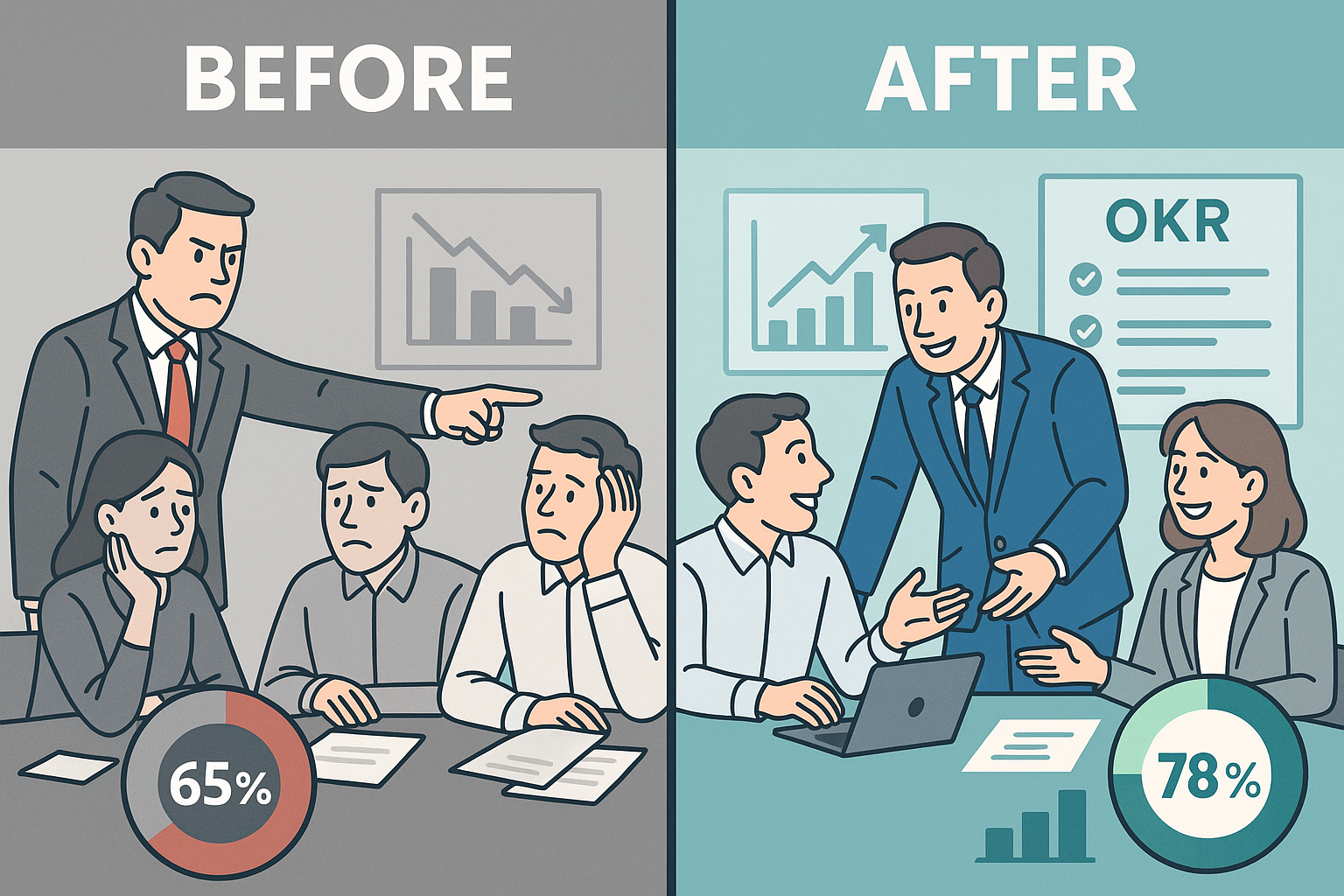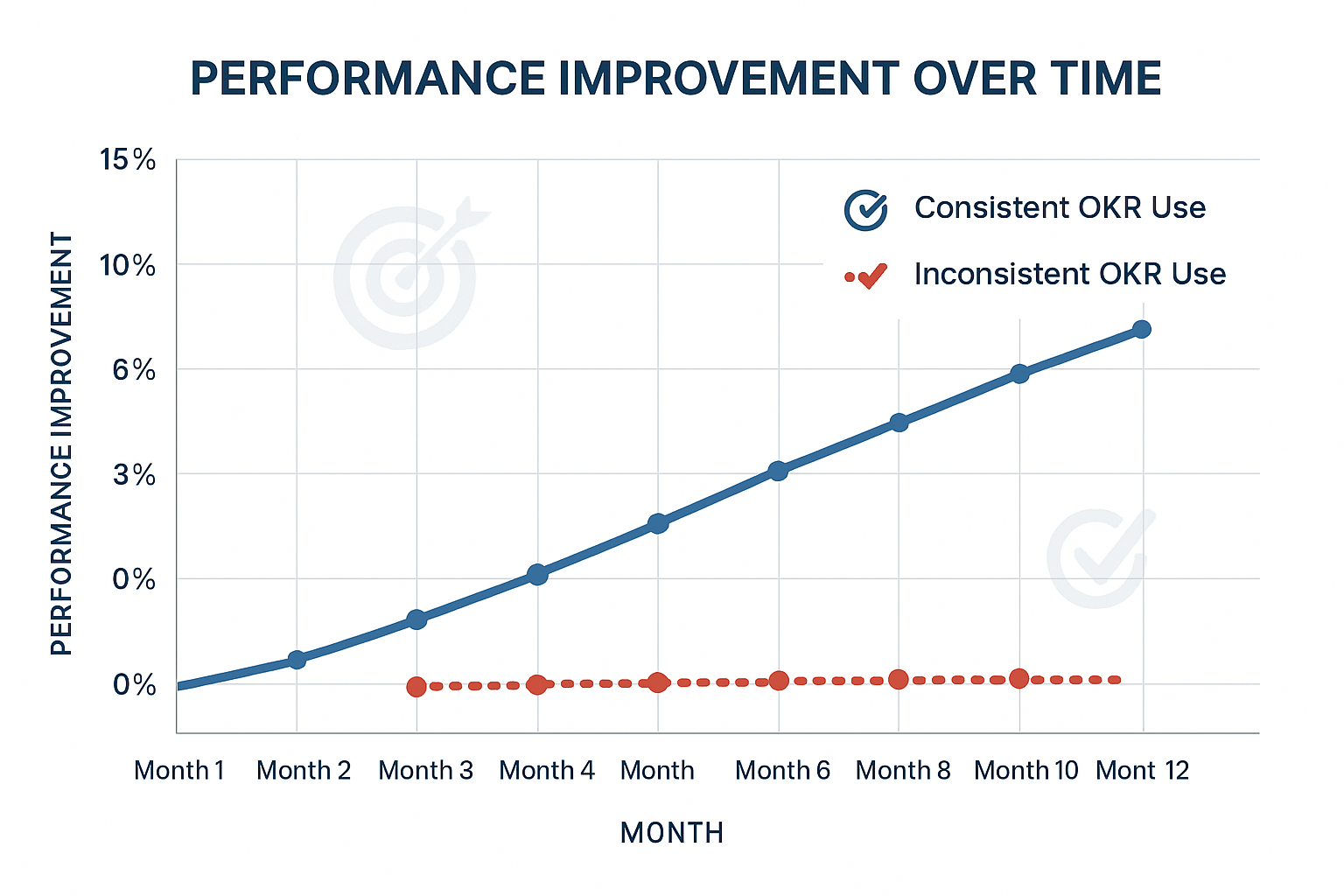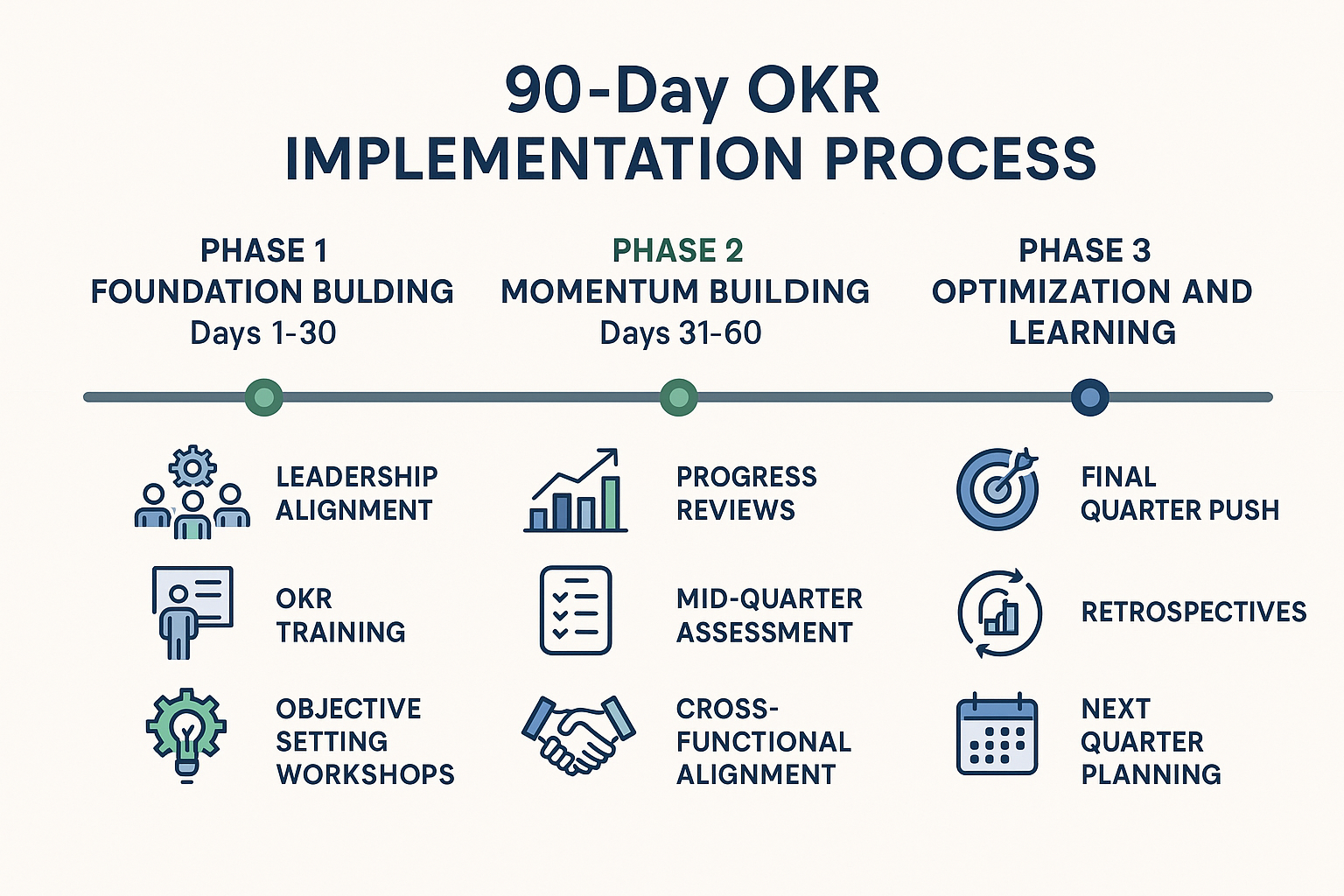How OKR Planning Improves Manager Performance
Manager performance challenges have reached a tipping point in 2025. Remote work dynamics keep shifting, digital transformation accelerates daily, and accountability pressures intensify across every industry. Here’s the reality: Traditional annual reviews and scattered goal-setting approaches can’t keep up with today’s business velocity.
The most successful organizations have discovered their secret weapon—OKR (Objectives and Key Results) planning. This framework doesn’t just improve team performance; it fundamentally transforms how managers lead, communicate, and execute.
When you implement OKRs correctly, you create a cascade of performance improvements that ripple through your entire organization. The results? Quantifiable improvements in engagement, productivity, and strategic alignment.
Key Takeaways
- Strategic alignment through OKR planning transforms managers from task coordinators into strategic leaders by creating transparent connections between daily activities and organizational objectives. Research shows 83% of companies report positive organizational impact from OKR implementation.
- Consistent OKR use increases high performance likelihood by 11.5% compared to only 3% for inconsistent adoption. This proves that disciplined quarterly cycles and regular check-ins far outperform sporadic goal-setting approaches.
- Employee engagement improves by 13 percentage points when managers use OKR planning (78% vs 65% job satisfaction). The framework enables managers to provide clearer expectations, regular coaching opportunities, and meaningful feedback loops.
- Weekly progress reviews maintain momentum and enable rapid course correction rather than waiting for monthly or quarterly check-ins. High-performing managers identify obstacles early and keep teams focused on impactful activities.
- Avoid treating OKRs as individual performance evaluation measures since this creates risk-averse behavior and easily achievable objectives rather than the ambitious stretch goals that drive innovation.
Why Strategic Alignment Makes Managers More Effective
The foundation of improved manager performance lies in crystal-clear strategic alignment.
OKR planning eliminates the ambiguity that plagues many management roles. How? By creating transparent connections between daily activities and organizational objectives.
This clarity transforms managers from task coordinators into strategic leaders.
The impact is both measurable and significant. According to recent research from a consultancy, 83% of surveyed companies agree that OKRs have a positive impact on their organization. This widespread recognition reflects how OKR planning strengthens managerial ability to drive positive organizational outcomes through enhanced accountability structures.
Traditional vs. OKR-Driven Management Comparison
| Performance Area | Traditional Management | OKR-Driven Management |
|---|---|---|
| Goal Clarity | Annual objectives, often vague | Quarterly objectives with measurable key results |
| Progress Tracking | Quarterly check-ins | Weekly pulse checks with real-time data |
| Team Alignment | Top-down directive communication | Transparent, cross-functional goal visibility |
| Adaptability | Rigid annual plans | Agile quarterly resets with learning integration |
Real-World Success Story
One Fortune 500 retail company faced overwhelming supply-chain complexity and omnichannel customer-experience challenges. These issues caused misaligned priorities and sluggish decision-making. By implementing structured, company-wide OKR planning that linked supply-chain, customer experience, and innovation objectives, they achieved:
- 90% rise in operational alignment
- 100% goal transparency across business units
- 15% boost in overall team productivity within one year
This transformation happened because managers finally had a framework that connected their daily decisions to company-wide success metrics.
How OKRs Boost Employee Engagement and Leadership Effectiveness
Outstanding managers understand a simple truth: team performance directly correlates with employee engagement levels.
OKR planning provides managers with a proven framework for creating the clarity, purpose, and feedback loops that drive higher job satisfaction and productivity.
The connection between OKR planning and engagement is backed by compelling data. Research shows that 78% of employees using OKRs report job satisfaction, compared with only 65% in organizations without OKRs.
This 13-percentage-point improvement represents millions of more engaged employees across the global workforce. The improvement comes directly from the clearer expectations and more effective feedback cycles that OKR-trained managers provide.
What Changes When Managers Embrace OKR Planning?
Transparent Communication: Managers share not just what needs to be done, but why it matters and how success will be measured.
Regular Check-ins: Weekly OKR reviews replace sporadic performance conversations with consistent coaching opportunities.
Collaborative Problem-solving: Teams work together to identify obstacles and adjust key results based on real-world learning.
Recognition and Growth: Managers can celebrate specific achievements and identify development opportunities through clear performance metrics.

“OKR planning transforms managers from directive leaders into coaching leaders. Instead of simply assigning tasks, managers become strategic partners who help team members connect their work to meaningful outcomes and provide continuous support for achieving ambitious goals.”
Case Study: Edelweiss Alternative Asset Advisors
Edelweiss Alternative Asset Advisors faced ambitious growth targets that weren’t translating into measurable execution. Their managers lacked a common framework for accountability. By implementing OKR planning into their management cadence through strategic workshops, alignment sessions, and quarterly reviews, they achieved:
- Accelerated year-over-year business growth
- Expanded their product portfolio
- Improved talent retention
- Fostered a culture of ownership and collaboration among managers
The Performance Impact of Consistent OKR Implementation
Here’s the most compelling evidence for OKR planning’s impact on manager performance: longitudinal studies tracking consistent implementation versus sporadic adoption.
The data reveals that consistency, not perfection, drives extraordinary results.
A landmark case study at Google demonstrates this principle powerfully.
OKRs have been a significant factor in Google’s success, helping them achieve 10x growth multiple times.
This remarkable performance difference underscores the critical importance of disciplined, ongoing OKR cycles rather than ad-hoc goal setting.
What Consistent OKR Planning Creates for Managers
Predictable rhythms for team communication that eliminate confusion about when and how to discuss progress.
Reliable frameworks for decision-making that help managers prioritize competing demands effectively.
Organizational muscle memory for executing strategic priorities that builds capability over time.
The operational benefits extend far beyond individual team performance. Managers who consistently apply strategic OKR frameworks report:
- Improved cross-functional collaboration
- Faster response times to market changes
- Enhanced ability to cascade organizational priorities into actionable team objectives

Your Step-by-Step Framework for Manager Implementation
Successful OKR planning requires managers to master both the technical mechanics of goal-setting and the leadership skills needed to drive adoption and sustained execution.
The most effective approach combines structured methodology with flexible application tailored to each team’s unique context.
The Quarterly OKR Cycle: Your Foundation for Success
The quarterly OKR cycle provides the foundational rhythm for manager effectiveness. This timeframe balances the need for meaningful progress with the agility required to adapt to changing business conditions.
Within each quarter, establish these three core practices:
1. Strategic Alignment Sessions (Week 1 of Each Quarter)
Connect team objectives to broader organizational priorities at the beginning of each quarter. Effective managers spend significant time ensuring every team member understands:
- Their individual key results
- How their work contributes to company-wide success
- The specific metrics that define success
This alignment creates intrinsic motivation and reduces the need for constant managerial oversight.
2. Weekly Progress Reviews (Every Week)
Maintain momentum and enable rapid course correction through weekly check-ins. Rather than waiting for monthly or quarterly reviews, high-performing managers integrate OKR discussions into:
- Regular team meetings
- One-on-one conversations
- Project status updates
This frequency ensures obstacles are identified early and teams remain focused on their most impactful activities.
3. Quarterly Retrospectives (Final Week of Each Quarter)
Capture learning and inform future goal-setting through structured reflection. Outstanding managers use OKR completion data to:
- Measure success against objectives
- Understand patterns in team performance
- Identify capability gaps
- Refine their leadership approach for subsequent quarters
Hyperdrive’s Proven OKR Implementation Timeline
Based on our experience helping Fortune 500 companies implement OKR frameworks, here’s your 90-day implementation roadmap:
Days 1-30: Foundation Building
- Week 1: Leadership alignment and OKR training
- Week 2: Objective setting workshops
- Week 3: Key result definition and measurement setup
- Week 4: First weekly check-in process establishment
Days 31-60: Momentum Building
- Weeks 5-8: Weekly progress reviews and course corrections
- Mid-quarter assessment and adjustment
- Cross-functional alignment verification
Days 61-90: Optimization and Learning
- Weeks 9-12: Final quarter push and achievement tracking
- Quarterly retrospective and learning capture
- Next quarter planning and improvement integration

Common Pitfalls That Sabotage Manager Success (And How to Avoid Them)
Even well-intentioned managers can undermine OKR effectiveness through common implementation mistakes. Understanding these pitfalls helps you avoid costly missteps and accelerate your path to improved results.
Pitfall #1: Treating OKRs as Performance Evaluation Measures
The Problem: When managers tie OKR achievement directly to compensation or promotion decisions, team members become risk-averse and set easily achievable objectives.
The Solution: Use OKRs as team collaboration frameworks, not individual performance metrics. Focus on learning and improvement rather than punishment for missed targets.
What Success Looks Like: Teams set ambitious stretch goals that drive innovation and breakthrough thinking.
Pitfall #2: Creating Administrative Burden Instead of Value
The Problem: Managers implement OKRs as separate, additional processes that create overhead without corresponding benefits.
The Solution: Embed OKR tracking into existing project management platforms, team communication channels, and reporting structures.
What Success Looks Like: OKR discussions feel natural and integrated into daily work rather than burdensome add-ons.
Pitfall #3: Maintaining Directive Leadership Styles
The Problem: Traditional directive leadership styles conflict with the collaborative, outcome-focused mindset that OKRs require.
The Solution: Transition from task assignment to strategic guidance. Help team members identify solutions rather than prescribing specific activities.
What Success Looks Like: Managers become coaches who enable team success rather than controllers who dictate activities.
Calculating the ROI of Your OKR Investment
Quantifying the return on OKR planning investments enables you to make data-driven decisions about resource allocation and program expansion.
Leading Performance Indicators to Track
Employee Engagement Scores
- Baseline measurement before OKR implementation
- Quarterly tracking during implementation
- Target: 10-15 percentage point improvement within 12 months
Goal Achievement Rates
- Percentage of key results achieved each quarter
- Target: 70-80% achievement rate (indicating appropriate stretch goals)
Cross-Functional Collaboration Frequency
- Number of cross-team projects initiated
- Speed of cross-functional problem resolution
- Target: 25-30% improvement in collaboration metrics
Time-to-Market for Key Initiatives
- Average time from concept to launch
- Target: 15-20% reduction in development cycles
Financial Impact Calculations
Revenue per Employee Improvement
- Baseline: Current revenue per employee
- Target: 10-15% improvement within 18 months
- Calculation: (New Revenue per Employee - Baseline) × Number of Employees
Customer Satisfaction Score Enhancement
- Baseline: Current customer satisfaction metrics
- Target: 5-10 point improvement on satisfaction scales
- ROI: Increased customer retention and referral rates
Operational Efficiency Gains
- Baseline: Current operational cost per unit of output
- Target: 8-12% efficiency improvement
- Calculation: (Baseline Cost - New Cost) × Annual Output Volume
Real ROI Example: Mid-Size Technology Company
A 500-employee technology company implemented comprehensive OKR planning with the following results:
Investment:
- Training and certification: $50,000
- Implementation consulting: $75,000
- Internal time investment: $100,000
- Total Investment: $225,000
Returns (Year 1):
- 12% improvement in revenue per employee: $2.4M
- 15% reduction in project overruns: $800K
- 20% improvement in customer retention: $1.2M
- Total Returns: $4.4M ROI Calculation: ($4.4M - $225K) / $225K = 1,855% ROI
Scaling OKR Success Across Your Organization
Individual manager success with OKR planning creates opportunities for enterprise-wide transformation when you provide proper support structures and continuous learning resources. The most successful implementations combine manager autonomy with organizational consistency through shared frameworks and ongoing education.
Enterprise Success Story: Hostinger’s Sustainability Initiative
Hostinger demonstrates effective scaling in their sustainability initiatives. By integrating OKR planning into their enterprise-wide sustainability strategy, they engaged every team and manager, including C-suite leadership, in:
- Quarterly OKR setting sessions
- Monthly KPI reviews
- Cross-functional sustainability projects
Results:
- Strengthened ESG leadership accountability
- Increased cross-functional engagement
- Empowered their Sustainability Manager role to drive continuous improvement across the organization
Building Your Organizational OKR Capability
Comprehensive Training Programs that address both tactical OKR skills and strategic leadership development.
Managers require practical instruction in:
- Objective-setting methodologies
- Key result measurement techniques
- Progress tracking systems
- Team facilitation skills
Ongoing Coaching Support in the cultural and behavioral changes that sustained OKR success demands.
Shared Frameworks and Resources that ensure consistency while allowing team-specific adaptation.
For leaders ready to transform their management effectiveness through proven OKR frameworks, explore our OKR certification courses that provide expert-led instruction, practical implementation resources, and the strategic insights needed to drive measurable performance improvements across your organization.
Frequently Asked Questions About OKR Planning for Managers
1. How long does it take to see results from OKR implementation?
Most organizations see initial improvements in team alignment and communication within 30-45 days of implementation. Measurable performance improvements typically appear within one full quarter (90 days), while significant cultural and engagement changes develop over 6-12 months of consistent use.
The key is maintaining disciplined weekly check-ins and quarterly cycles rather than expecting immediate transformation.
2. What’s the ideal number of objectives and key results for each manager?
Best practice recommends 3-5 objectives per quarter, with 2-4 key results per objective. This provides enough focus to drive meaningful progress without overwhelming teams with too many priorities.
Remember: OKRs should represent your most important goals, not everything your team works on. Aim for objectives that require 60-70% of your team’s effort, leaving room for day-to-day operational work.
3. How do you handle OKRs when priorities change mid-quarter?
Agility is a core principle of effective OKR planning. When significant business changes occur, it’s appropriate to adjust key results or even objectives mid-quarter. The process should include:
- Documenting why changes are necessary
- Involving the team in adjustment decisions
- Maintaining focus on learning rather than perfect execution
- Using changes as input for next quarter’s planning
4. Should OKRs be tied to individual performance reviews and compensation?
No. Tying OKRs directly to performance evaluations creates risk-averse behavior and encourages easily achievable goals rather than ambitious stretch targets. Instead, use OKRs to:
- Guide development conversations
- Identify learning opportunities
- Celebrate team achievements
- Inform capability building needs
Individual performance should be evaluated through separate frameworks that consider OKR contribution alongside other factors.
5. How do you maintain momentum when teams consistently miss their key results?
Consistent misses often indicate one of three issues:
- Overly ambitious targets: Adjust key results to be challenging but achievable (aim for 70-80% success rate).
- Insufficient resources or support: Identify and address capability gaps, resource constraints, or process obstacles.
- Misaligned objectives: Ensure objectives connect clearly to business priorities and team capabilities.
Use quarterly retrospectives to diagnose root causes and adjust your approach. Remember: learning from misses is more valuable than hitting easy targets.
Ready to transform your management effectiveness through proven OKR frameworks? Discover our comprehensive OKR certification programs designed specifically for leaders who want to drive measurable performance improvements across their organizations.
Questions? We Can Help.
When you’re ready to move beyond piecemeal resources and take your Agile skills or transformation efforts to the next level, get personalized support from the world’s leaders in agility.